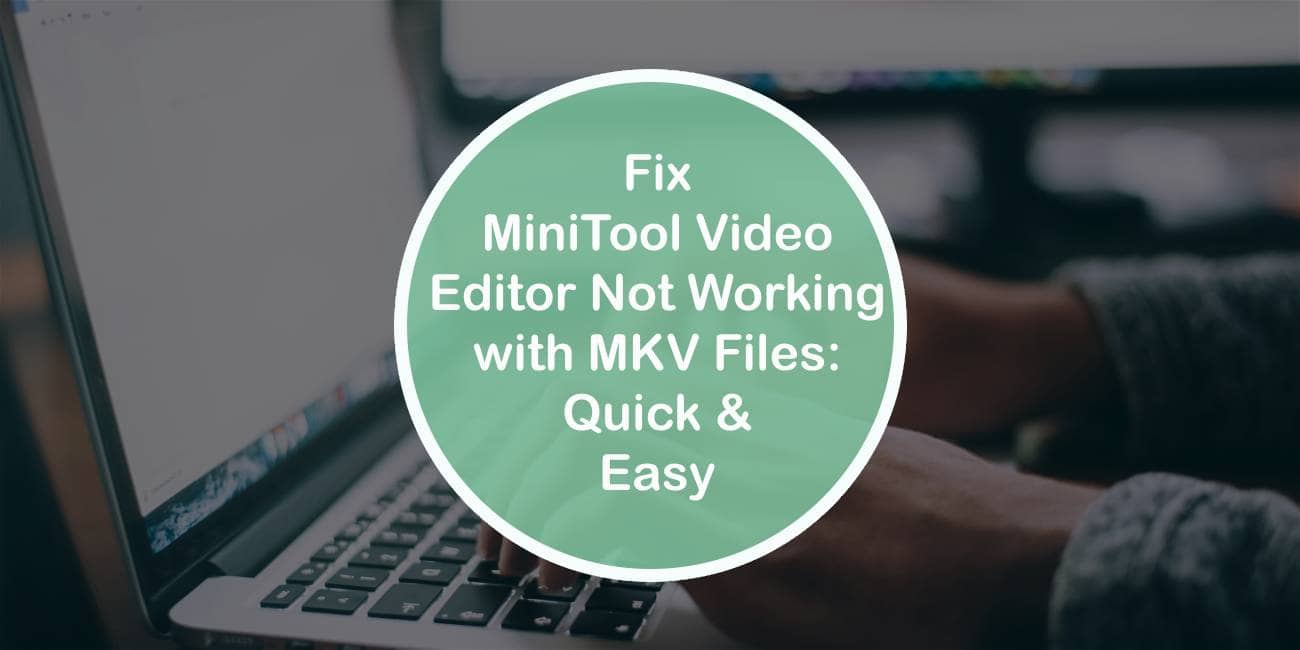Imagine this: you’ve just finished shooting the perfect video, full of stunning visuals and memorable moments, only to find yourself stuck in a frustrating loop trying to edit it with MiniTool Video Editor. You load your MKV files, but instead of seamless editing magic, you’re met with error messages and unexpected crashes. If you’ve ever faced this daunting scenario, you’re not alone. Many users cherish MiniTool for its user-friendly interface and robust features but encounter headaches when dealing with MKV formats.
Fear not—this article is your gateway to troubleshooting these pesky issues! We’ll delve into quick and easy solutions that will have you back on track in no time. Whether you’re a seasoned editor or just starting out, understanding how to navigate these tech hiccups will empower you to make the most of your editing experience. Read on as we uncover effective strategies that will turn those frustrations into creative triumphs!
Common Causes of MKV File Problems
MKV files, or Matroska Video files, are revered for their versatility in storing multiple audio and subtitle tracks alongside high-quality video. However, users often encounter issues when trying to edit or play these files in various applications. One common culprit is codec incompatibility; MKV uses a variety of codecs for its streams, and if the necessary codec isn’t installed or supported by the software you’re using, playback can be choppy or entirely non-functional. This often leaves users frustrated as they wrestle with decoders to get their videos working properly.
Another frequent issue arises from corrupted files. MKV format supports features such as chapter breaks and multiple subtitling options, but these complex elements can sometimes lead to file corruption during download or transfer processes. Partial downloads or interruptions while saving can create glitches that prevent smooth editing or viewing. Understanding that not all media players handle MKV in the same way also adds another layer of complexity; some players may skip certain frames due to compatibility concerns while others manage them flawlessly. Improving your experience with MKV requires not just the right tools but also awareness of these underlying challenges—knowing what could go wrong helps facilitate smoother editing and playback experiences down the line.

Check for Software Updates Regularly
One of the often-overlooked aspects when troubleshooting issues with MiniTool Video Editor—or any software for that matter—is the significance of regular software updates. Software developers continuously refine their applications, patching bugs and optimizing performance to accommodate evolving file formats like MKV. By checking for updates regularly, users can ensure they’re leveraging the latest features and improvements, which may significantly enhance compatibility and functionality.
Moreover, keeping your software up-to-date isn’t just about accessing new features; it’s also crucial for security. An outdated version may contain vulnerabilities that malicious entities could exploit. By embracing a routine check for updates, you not only bolster your experience with MiniTool Video Editor but also fortify your device against potential threats. This proactive approach helps minimize disruptions—allowing you to focus more on creativity rather than technical hiccups—and ensures that you enjoy seamless video editing without hesitation.
Reinstalling MiniTool Video Editor Steps
If you find yourself grappling with issues involving MKV files in MiniTool Video Editor, a thorough reinstallation can breathe new life into your editing experience. To begin, ensure you back up all your projects and user settings to avoid losing valuable work. Head over to the Control Panel, uninstall the application, and carefully remove any leftover files or folders associated with MiniTool. This step is crucial in preventing conflicts from previous installations that could hinder performance.
After you’ve cleaned house, download the latest version of MiniTool Video Editor directly from their official website. Check for any updates or patches specifically targeting MKV file compatibility before proceeding with installation. When installing, consider selecting custom options if available; this allows you to optimize settings tailored to your editing style and hardware capabilities. Once installed, reopen the software and test it by importing various MKV files—this fresh setup should ideally resolve persistent glitches, ensuring smoother edits moving forward.

Convert MKV Files to Compatible Formats
When dealing with MKV files in MiniTool Video Editor, a common challenge is compatibility issues that can hinder your editing process. Converting MKV files to more widely accepted formats like MP4 or AVI not only enhances versatility but also ensures smoother playback during editing. Using conversion software allows for quick adjustments in file attributes, enabling you to tailor the output resolution and bitrate for optimal performance tailored to your project’s needs.
Moreover, leveraging cloud-based conversion tools offers an added convenience—no need for downloads or bulky installations. Simply upload your MKV file and receive a compatible version within minutes, streamlining workflow significantly. Keep in mind that during the conversion process, preserving video quality should be a priority; choosing tools that support high-quality codecs will ensure you keep all the intricate details intact while transforming those stubborn MKVs into seamless editable formats. Embracing these strategies not only resolves compatibility issues but also opens up new possibilities for creativity through enhanced editing capabilities.
Adjust Video Codec Settings in Editor
When working with MKV files in MiniTool Video Editor, adjusting video codec settings can dramatically enhance editing performance and compatibility. Many users overlook the importance of the right codec, but it’s a vital aspect that determines how your editor processes video data. For instance, switching from a less compatible codec to H.264 or HEVC can not only improve playback fluidity but also significantly reduce file size without sacrificing quality.
Delving into the advanced settings reveals options where you can customize parameters like frame rate and bitrate. Fine-tuning these settings based on your project’s needs ensures that you maintain an optimal balance between quality and rendering speed. This is especially crucial when exporting large projects; correct configurations prevent frustrating lags and glitches during exportation—a common pain point for many editors struggling with MKV formats. By embracing these adjustments, you empower your creative process while avoiding technical bottlenecks that impede productivity.

Clear Application Cache and Temporary Files
One often overlooked yet surprisingly effective solution to fix issues with MiniTool Video Editor, particularly regarding MKV files, is clearing the application cache and temporary files. Over time, these caches can become bloated with outdated data that not only occupies valuable storage but may also interfere with the software’s ability to function smoothly. By regularly clearing this clutter, you can revitalize the performance of your video editor and potentially prevent future hiccups during your editing tasks.
To clear the cache effectively, navigate to your system settings or preferences within MiniTool Video Editor and look for options related to storage or cache management. This process varies based on the operating system you’re using; a simple search can guide you through specific steps tailored to your setup. Embracing this practice not only frees up space but also helps ensure that any corrupt or conflicting data that might affect file compatibility is eliminated, paving the way for a more seamless editing experience—especially when working with diverse formats like MKV.
Furthermore, consider incorporating regular maintenance of both application cache and temporary files into your workflow routine. By doing so, you’ll enhance overall efficiency while reducing wait times for rendering or exporting projects—an invaluable asset for anyone tackling multiple video projects concurrently. Taking proactive measures now could save heaps of frustration down the line!
Conclusion: Resolving MKV Playback Challenges
Resolving MKV playback challenges often requires a multi-faceted approach, especially when traditional fixes fall short. One effective strategy is to leverage an array of file conversion tools, which can seamlessly transform MKV files into formats more compatible with your player. While this process might seem tedious initially, the benefits are twofold: you ensure your videos play smoothly and gain insights into the various codecs that enhance media compatibility across devices.
Moreover, exploring specialized media players can be a game changer. Certain software offers built-in support for MKV files and their unique attributes—such as multiple audio tracks or subtitle files—without extensive configuration. By broadening your toolkit with versatile players or editors like MiniTool Video Editor, you’re not just solving playback issues; you’re expanding your viewing experience to include greater richness in video quality and functionality. Ultimately, embracing diverse solutions tailored to your specific needs not only resolves current challenges but also prepares you for any future media hurdles that may arise on your digital journey.

